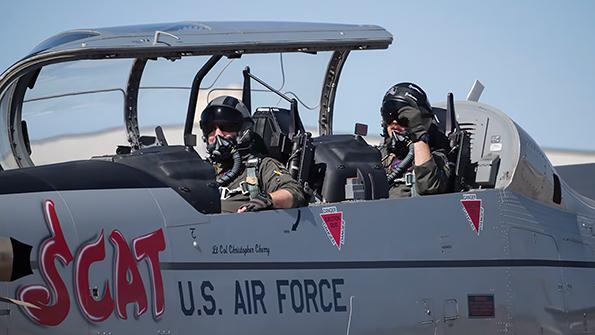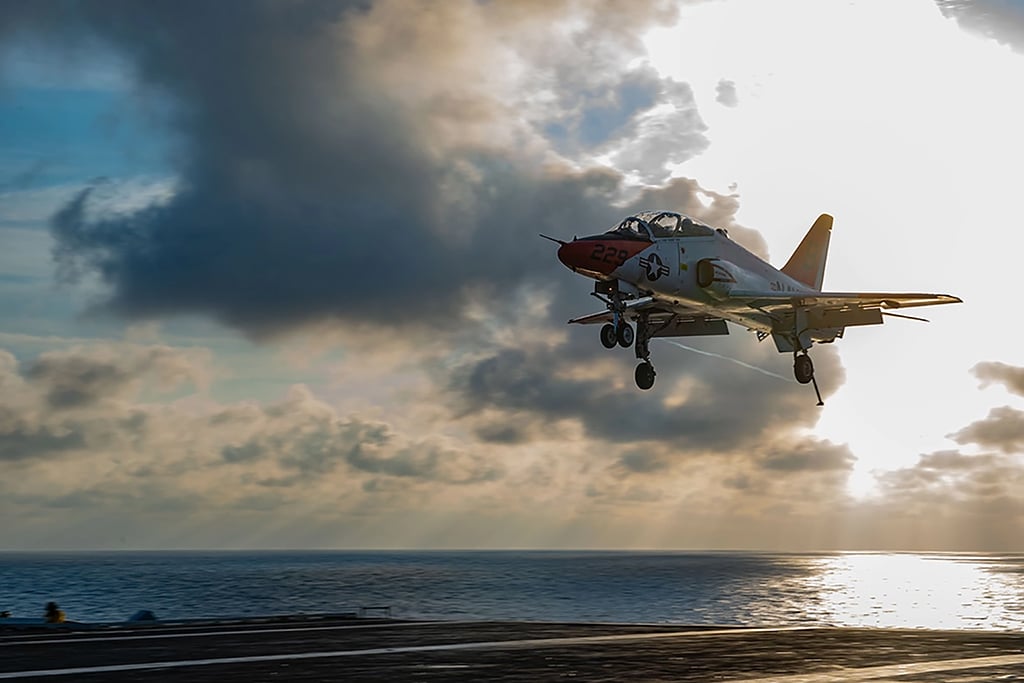This article is published in Aviation Week & Space Technology and is free to read until May 10, 2024. If you want to read more articles from this publication, please click the link to subscribe.

The Air Force is accelerating pilot training on the T-6 as it faces a persistent aircrew shortage.
For more than five years, the U.S. Air Force has deemed its pilot shortage a crisis. It has established a task force, approved large-scale increases in retention bonuses and found ways to streamline pilot production to put more personnel into its cockpits.
Come fiscal 2023, the shortage has largely stayed the same, at just under 2,000 pilots. The Air Force is continuing to try to convince pilots to stay in uniform, with renewed outreach that takes a long-term look at career pressures and which retention efforts are actually working. In the meantime, the service is prioritizing its operational and training units while making big reductions in areas such as testing.
- The Air Force is prioritizing operational units, reducing staff roles
- The Navy is spending more on T-45 readiness
“We are listening to aircrews,” Lt. Gen. Adrian Spain, deputy chief of staff for operations and former director of training and readiness, tells Aviation Week. “We want their feedback. We are fighting for it at every opportunity we can, and we are demonstrably trying to meet them in a place that can help incentivize continued service within the confines and constructs they have for support networks, for their culture.”
At the end of fiscal 2023, the Air Force’s pilot shortage grew by 206 from the prior year to 1,848. The service blames increased post-COVID-19 airline hiring and a continuing underproduction in pilot training. Undergraduate pilot training production was stable at 1,300 for 2023, about 200 below a target rate of 1,500 per year.
In some ways, the situation has worsened because the Air Force cannot pinpoint the shortage to individual communities. In the early stages of the crisis, the service could produce mobility pilots faster than fighter pilots, giving tanker and airlift fleets more buffer space in staffing levels. It is all-encompassing today.
“Most communities that we’re talking about have some stress that’s being applied to them,” Spain says.
The Air Force has rolled out various types of bonuses to keep aviators around, yet numbers remain stagnant. Legacy bonus contracts kept 291 pilots in service in fiscal 2023, compared with 285 in fiscal 2019. The service in 2023 launched a bonus demo program for early-career pilots, contracting 230 who had two years until their undergraduate pilot training active-duty service commitment expiration and 143 who had three years.
The Aircrew Crisis Task Force is reaching out directly in a new survey program targeting individual pilots instead of gathering anonymous responses. The first round of questions went out last year. It aims to focus not just on initial feedback but on years of continued engagement, Spain says. He explains that the goal is to “pinpoint things that are working, . . . not working and . . . not measurably making a difference.
“We have one survey right now, and it’s going through the analysis phase,” he says. “But the method of this survey is different in the way that, over time, we can actually measure the change in the sentiment for individuals.”
For now, training and operational units are crewed at about 100%, while testing units are staffed at about 75%, and personnel is lower, though an exact percentage is not available. In February, the service took a dramatic step to try to alleviate the staff shortage, announcing a program to entice back retired officers.
Beyond money, pilots have shared with headquarters concerns about their career paths that make leaving the service and taking an airline job more attractive. These largely focus on improved stability, predictability and flexibility in civilian career paths.
One concern seems basic on the surface but has been complicated to address: Pilots simply want to fly. The Air Force says it budgets flying hours to the maximum executable level, but with many aircraft aging and facing maintenance issues, the hours have been hard to achieve.
Consider the Boeing F-15Es flown by the 366th Fighter Wing at Mountain Home AFB, Idaho. The wing has ongoing maintenance issues with its aircraft, which are more than 30 years old. The base’s maintainers are doing great work, considering the circumstances, Wing Commander Col. Michael Alfaro tells Aviation Week. He says his guidance is to try to meet the mission-hour goal without breaking the wing’s jets or breaking the people. Aviation Week recently visited the 366th.
With older airframes, that can mean pilots expect to fly often but do not. They can repeatedly show up early at the operations desk, only to be told there are not enough working aircraft.
Alfaro says that earlier in his career, it was normal to fly 15-20 times per month, including multiple times per day. Today’s Air Force often must play “shell games,” he notes, prioritizing a group one month to maintain currency, then having them essentially on probation for the next to give others a chance to fly.
“We’re just barely getting the sorties across people,” he says. “The ones that need experience are not getting sorties, so that can be a little bit of a beatdown on morale.”
Meanwhile, the Air Force is starting to chip away at what has become a major limiting factor in pilot production: the health of its Northrop T-38 Talon II trainer. The Talon uses General Electric J85 turbojet engines dating back to the early 1950s, and problems with those engines have decreased its mission-capable rates to the low 50% range, in turn lowering pilot output. Moreover, the powerplant is no longer in production, and StandardAero, the main contractor charged with maintenance, has struggled to source parts.
In response, the newly renamed Airman Development Command (ADC)—previously Air Education and Training Command—teamed with Air Force Materiel Command to develop a new plan to produce and refurbish parts in-house to feed into depot maintenance.
Commander of the ADC, Lt. Gen. Brian S. Robinson, tells Aviation Week that this process has already yielded results in the past couple of months, helping a “better-quality engine to come out of depot maintenance.”
In addition, the Air Force has launched the broader Talon Repair Inspection and Maintenance program to inspect and repair critical structure areas. This is expected to replace nearly 200 primary structure components, including longerons, bulkheads and skins, and to inspect more than 150 other components.
These are all interim steps as the service awaits the delayed Boeing T-7A Red Hawk. The aircraft’s anticipated initial operational capability date has been pushed to 2028. Robinson says concerns over the T-7’s delayed timeline stem from having to put more resources into extending the T-38’s life, as the service prefers the safer, more capable and more advanced Red Hawk.

Per the current T-38 syllabus, much of early training covers simply safe flight of the old aircraft and its unique characteristics, as opposed to military airmanship. The more advanced T-7 will allow the service to provide much improved training, Robinson says.
Before pilots fly the T-38—and eventually the T-7—they begin training in the Beechcraft T-6 Texan II turboprop. As the Talons have declined, the service has made limited changes to the T-6 initial training syllabus—focused on process, sustainment, manpower and airspace access—to raise the output of trained pilots. Robinson says these tweaks have increased production by 25% at Laughlin AFB, Texas, and will be scaled to other locations starting with Vance AFB, Oklahoma.
The U.S. Navy faces a similar pilot shortage, both in production and in keeping enough strike pilots in service. As with the Air Force’s T-38 issue, the Navy continues to grapple with engine troubles from its T-45 Goshawk trainer. As of late 2023, the pipeline had produced 80% of its overall goal, with about 1,000 students at a time waiting to begin pilot training—some waiting as long as 14 months.
The T-45 was grounded for 4.5 months starting in October 2022. That same year, the Navy started the Carrier Qualification Pilot Project. Under this program, pilots would not be required to land on a carrier before going to fleet replacement squadrons. As of August 2023, 32 pilots had completed the program, with positive initial results.
The Navy’s fiscal 2025 request calls for $158 million for the T-45, including a $38.9 million “engine surge” account to deal with powerplant problems, $64 million to address avionics obsolescence and $28 million for a life extension program. Beyond that, the service plans to proceed with a replacement called the Undergraduate Jet Training System, procurement of which is to start in 2026, although funding has yet to be outlined.
Navy Secretary Carlos Del Toro says the funding and initial steps to address the T-45 have shown some results, sounding an optimistic note on addressing the overall shortfall. “Our pilot pipeline has come down dramatically,” he says. “I’m pretty excited about that.”






Comments